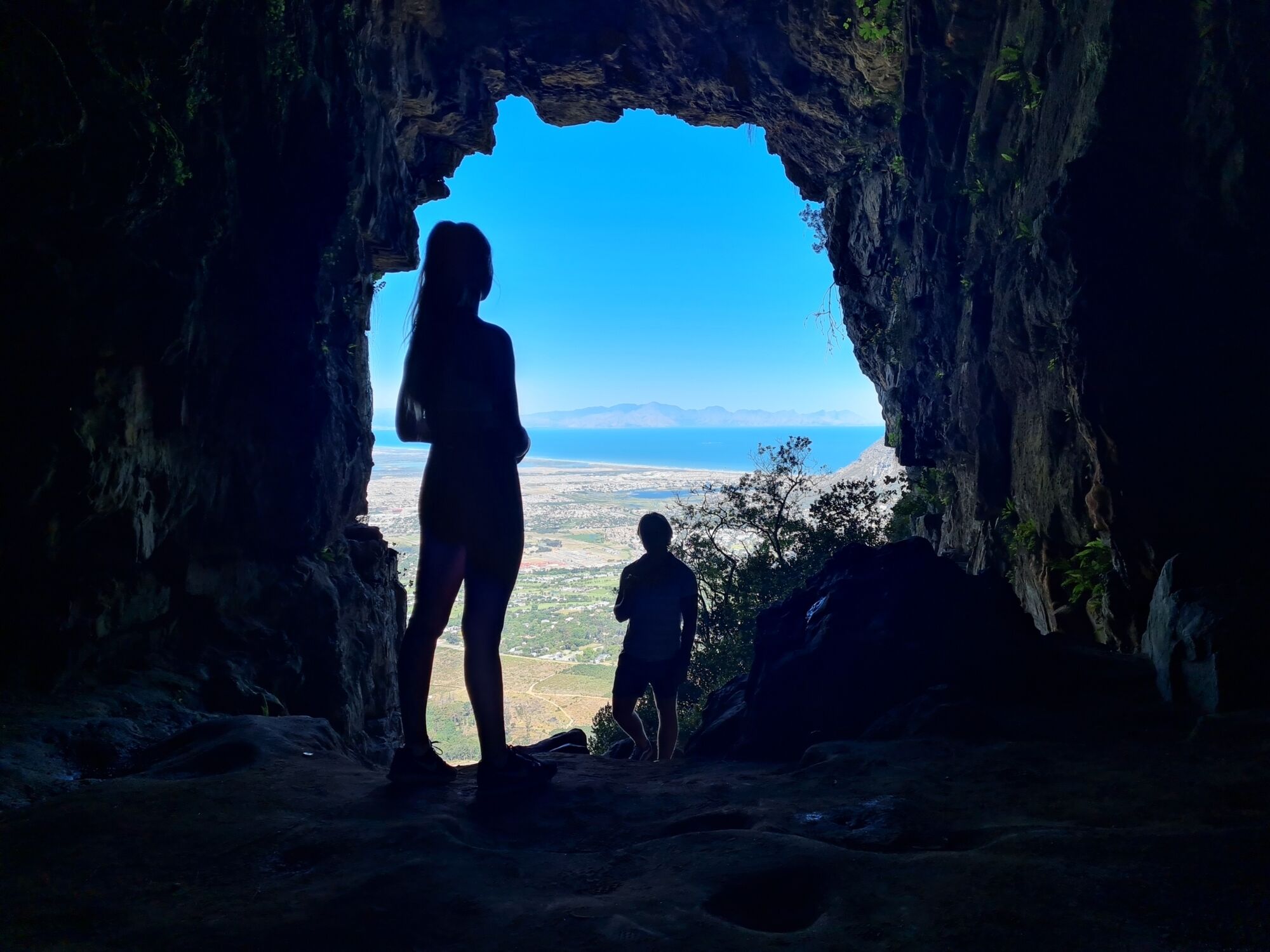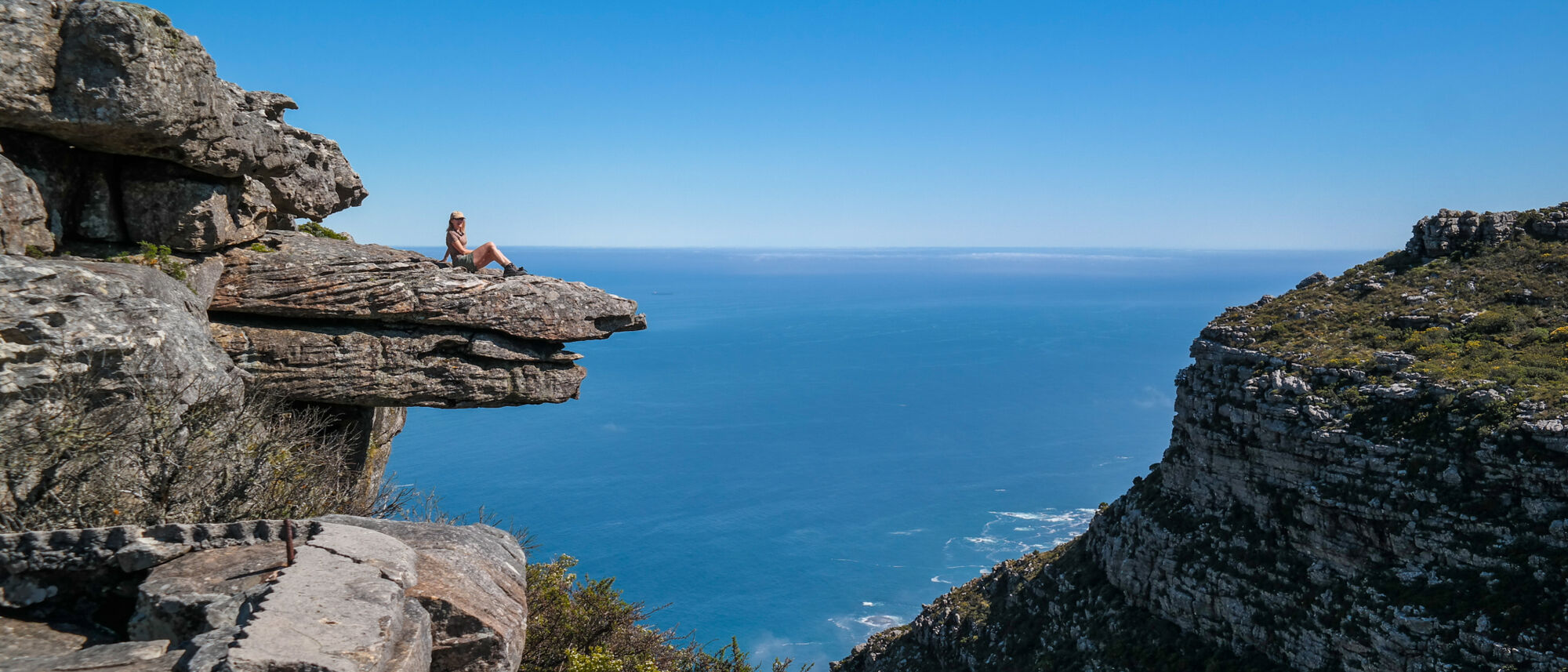1. Lion’s Head
It’s not surprising that this is one of the most popular day hikes in Cape Town. Your reward for reaching the summit is a panoramic vista, which is well worth the short 40-60 minute climb.
Not long after heading up the wide gravel path at the start, you’ll pass the paragliding launch site on your left. When conditions are right it’s not uncommon to see a number of colourful paragliders hovering on thermal air currents alongside Lion’s Head.
The spiralling route offers views of different aspects of the city and surrounds, as you wind your way up the mountain. The popular Camps Bay and Clifton Beaches (with their icy waters) tend to look incredibly inviting below.
From the other side you’ll look across to the front of Table Mountain with Devil’s Peak extending from its side and the city stretching out beneath. You’ll get to take in all of these views from the top, as well as the infamous Robben Island, which is clearly visible on a sunny day and looks like a giant pancake drifting in Table Bay.
Cost: Free entry
Take note: It’s not an overly strenuous hike and because of the beautiful views the route can get rather busy, with queues forming at the fixed chains that help climbers over some of the short, vertical rocks.
There is a marked alternative route, if you don’t fancy climbing the chains. It’s best to get an early start to avoid the crowds and difficulty finding parking along Signal Hill Road. Full moon hikes on Lion’s Head are popular too. Make sure you have a good headlamp and go in a group.
2. Kasteelpoort, Table Mountain
A favourite with those looking for the perfect Instagram shot, Kasteelpoort is a fairly steep climb up the side of Table Mountain, above Camps Bay. The route is easy to follow, although the numerous steps should give your legs a decent workout. Wonderfully, there’s a river near the top with a little footbridge, which makes a great place to soak your feet and look out over the ocean.
If you really need a photo of yourself on a ledge there is a fairly broad one, known as surfboard rock, jutting into thin air at the Old Cableway View Point at the top of the climb.
The start of the climb is marked and can be accessed from the Pipetrack which is a fairly flat route running along the base of Table Mountain.
Cost: Free entry
Tips: Extreme caution needs to be taken near any ledges or drop offs on the mountain and on windy days it is highly inadvisable to go onto Surfboard Rock.
3. Elephants Eye, Silvermine
For a relaxed hike, a walk to the Elephant’s Eye cave in Silvermine Nature Reserve within Table Mountain National Park is ideal.
It takes about 35 - 50 minutes to reach the cave from the parking area near the Silvermine Reservoir. This shady recess in the mountain – with ferns and moss growing inside and the occasional drops of water dripping from the ceiling – offers a cool respite and views over Tokai, the Cape Flats, Muizenberg and False Bay.
There are a number of longer hiking trails with views overlooking Hout Bay, Noorhoek and False Bay within the reserve. The most popular is the seven-kilometre circular route that starts at the reservoir to Noordhoek Peak and back. After hiking, you may be tempted to take a refreshing dip in the dam where you’ll also find shaded braai areas and picnic spots.
Cost: You need a permit to enter the reserve. These can be bought at the entry gate or you can use a valid Wild Card or Green Card to get in. Visit SanParks for current rates.
Take note: Swimming is usually allowed here, however during levels 3 and higher of lockdown, due to COVID-19, access to the picnic and swimming area has been restricted.

4. Oudeschip, Llandudno
This incredibly scenic hike will take you to the Harvest Capella shipwreck, on the Oudeschip Peninsula, which ran aground in 1986.
To begin this trail you’ll need to cross Cape Town’s only nudist beach, Sandy Bay and look for a trail on your left which leads into a milkwood grove. There are no signs but if you stick close to the coast you’ll soon find the trail that leads to the Peninsula. It takes about an hour to reach.
It makes sense to time your arrival at low tide so that you can walk across the rocks otherwise you’ll need to wade through the cold Atlantic water to get across.
When you reach your destination you’ll be able to enjoy views of Table Mountain, Lion’s Head, Little Lions Head and Karbonkelberg. The Bos 400 wreck, a French crane barge that was wrecked in 1994 can also be seen from here.
(There is an alternative route which can be accessed from the Hout Bay Dunes parking lot. However, the descent and returning ascent is rather steep).
Cost: Free access
Take note: We advise against hiking alone. Stick to groups and ensure others know what route you are planning on taking.
5. Constantia Nek, Table Mountain
If you’re not a fan of narrow, steep ascents that make you feel as if you truly are climbing the stairway to Heaven, Constantia Nek offers a wide and more gradual ascent of Table Mountain via jeep track. The trail can be accessed from the parking lot next to the Nek’s traffic circle and begins zig-zagging up the mountain on a well-shaded path.
There is a short cut which involves a more stepped climb between the trees, just be careful of tree roots that have been worn smooth and get slippery especially when wet on this section.
For an extended hike across the top of the mountain, you can make your way past the Overseers Cottage to the Hely-Hutchinson Dam. If you like, you can keep going on marked footpaths to MacClear’s Beacon, the highest point on Table Mountain. Then continue on to the Upper Cable Station to catch a ride down the front of the Cape Town’s most famous icon.
You’ll need to coordinate the logistics of getting back to Constantia Nek, if you have a vehicle parked here from the bottom of the Aerial Cable Way. The distance from Tafelberg Road to the Neck is about 22km by road.
For a shorter, easier hike, you could descend back down Constantia Neck after reaching the top of the path, or go as far as the Hely-Hutchinson Dam before retracing your steps.
Cost: Free entry. If you choose to descend via cable car, a one-way ticket for an adult costs R200. To see special offers and other pricing, visit tablemountain.net
Take note: The main trail is popular with dog walkers, hikers and trail runners and is a good route for a family hike.
6. Thomas T Tucker Shipwreck Trail, Cape Point
The visible shipwrecks strewn along the coastline of Cape Point Nature Reserve, at the southernmost tip of Table Mountain National park and of the Cape Peninsula, hint at the carnage beneath the waves.
The most easily accessible of these is the Thomas T Tucker, a liberty ship that carried supplies during World War II, which stuck Albatross Rock in 1942 on its maiden voyage.
Wild oceans, raging winter storms and hidden reefs, like Bellow’s Rock and Albatross Rock are part of the reason that 26 ships met their end along this coast.
Albatross Rock, which lies about 1,5km from the beach hidden beneath the water off Olifantsbos Point, has wrecked six ships. The first to hit this rock was a steam tug named Albatross, from which it derived its name.
To get to the Thomas T Tucker follow the yellow markers from the parking lot through the fynbos to the water’s edge. The route is about 3 kilometres long and a fairly easy walk. Another two kilometres further, you’ll find the wreck of the Nolloth. This Dutch ship was the last to be wrecked on Albatross Rock, in 1965 and bits of the ship can be found strewn along the beach.
Cost: A permit is required for entry. The standard entry fee for adults is R340 and R85 for South African with a valid ID. Visit capepoint.co.za for all the rates.
Take note: A map of the various trails within the reserve can be found at the Buffelsfontein Visitors’ Centre. Some of the fauna in the park includes Cape baboons, bontebok, eland, Cape mountain zebra and red hartebeest. The tail is also commonly referred to as the Olifantsbos Trail.
7. Paulsberg Cannon, Cape Point
This Cape Point Nature Reserve hiking trail differs from the largely coastal Thomas T Tucker Trail in that you gain some elevation and can enjoy magnificent views over Cape Point, the Atlantic Ocean and False Bay views.
The roughly 45 minute walk begins at the path behind Bordjies Rif parking lot and makes its way along the Farmer’s Cliff Trail. The Konnonkop hiking trail has a mixture of walking through sandy stretches on footpaths through the fynbos and some climbing to reach the old cannon on Paulsberg.
It’s thought that the old cannon was historically used to signal the Simon’s Town naval station of ships approaching False Bay. The sound of the cannon fire could be heard for about eight-kilometres under favourable weather conditions, which means that it would be audible at the naval station, which is six-kilometres away.
Cost: A permit is required for entry. Standard entry is R340 per adult and R85 for South African (adults) with a valid ID. Visit capepoint.co.za for all the rates.
Take note: There’s no shade on the hike, so make sure to wear a hat and carry some water. Because the walk is relatively short, there’ll be time to enjoy swimming at one of Cape Point’s beaches afterwards or a trip up the funicular.


















